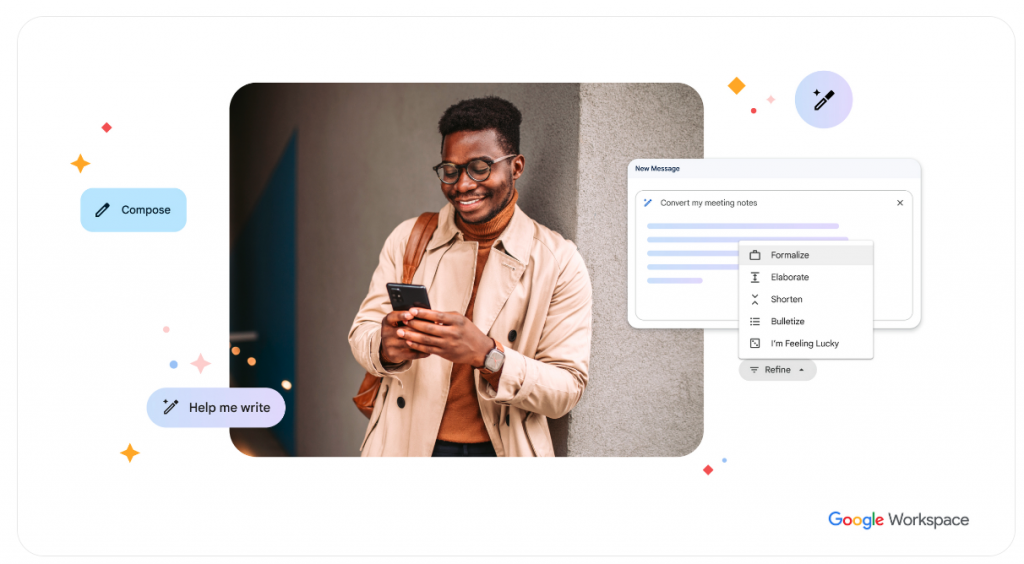Google has announced it will bring AI elements to Workspace, which means that in the future, marketers could have access to artificial intelligence across Gmail, Sheets, Docs, Slides, Meet and Chat.
The ‘in the future’ caveat is important because for now, Google says it has made AI available to a select number of testers.
Johanna Voolich Wright, Vice President, Product, Google Workspace
“We’re now making it possible for Workspace users to harness the power of generative AI to create, connect, and collaborate like never before. To start, we’re introducing a first set of AI-powered writing features in Docs and Gmail to trusted testers.”
How is Google bringing AI to Workspace?
Google Workspace is a paid-for business solution that brings together all of Google’s productivity tools, and provides users with a custom business email, extra storage per user, security and management controls and Google support.
It’s a cloud-first, browser-based system that also offers built-in controls, encryption and verification that enables employees to work from anywhere.
New Workspace features coming for 2023
And now, Workspaces users look set to be the first people to have access to features such as:
- Draft, reply, summarize, and prioritise your Gmail.
- Brainstorm, proofread, write, and rewrite in Docs.
- Bring your creative vision to life with auto-generated images, audio, and video in Slides.
- Go from raw data to insights and analysis via auto completion, formula generation, and contextual categorisation in Sheets.
- Generate new backgrounds and capture notes in Meet.
- Enable workflows for getting things done in Chat.
Marketers who spend a lot of time thinking of ideas for copy may be interested in Google’s generative AI in Docs and Gmail.
Johanna Voolich Wright, Vice President, Product, Google Workspace
“Whether you’re a busy HR professional who needs to create customized job descriptions, or a parent drafting the invitation for your child’s pirate-themed birthday party, Workspace saves you the time and effort of writing that first version.”
It’s interesting that Google specifically mentions saving time on the first version of something, which makes it clear that AI is not intended to produce the final product for marketers. Instead, it seems designed as a guide from which marketers tweak and add their own special sauce to create really compelling copy.
Google has also said its AI will be able to rewrite copy, or turn a few bullet points into a more polished piece of text.
Regardless, this could save businesses a lot of time – but there is also the risk that marketers start producing content that looks similar to competitors. As always, it will still pay to make sure whatever AI-guided content you publish is unique and serves to provide value to your audience.
Other ways Google is planning to deploy AI across Workspace
AI will also be deployed in other areas across Workspace. For example, AI can be used to create presentations.
Thomas Kurian, CEO, Google Cloud via Tech Crunch
“With Slides, we’re helping you generate insights and images from text in slides. So you can use images from your rich content library, your brand images — if you’ve got your own company’s images — and private repositories, to generate these images and superpower every person building with slides, including generating soundtracks.”
An announcement video produced by Google also shows how AI can automatically populate data in Sheets, or take notes during a Meet call or produce images.
And a rival to ChatGPT
But that’s not all. Google has recently released its rival to ChatGPT. It’s called Bard, and it’s available to certain users over the age of 18.
It’s also been released with a big caveat that Bard will not always get the answers right, and it will get better with time.
After OpenAI released ChatGPT, firms such as Microsoft and Google have raced to catch up. While ChatGPT’s database only goes back to 2021, Google’s is a lot more recent and can answer questions on news and current events from a few days ago.
As with AI tools like this, businesses can use it to create content, bits of code or use it to generate campaign ideas. It can also be used for fact-finding, and will namecheck sources of information.
However, it hasn’t had an easy introduction to life on the internet. While Google claims it worked hard to make sure it doesn’t lie, it still does. And to make matters worse, in the process of trying to make it fib-free, Google engineered all the personality out of its answers and Bard only gives cliched, dry responses. It’s a work in progress, for sure.




RECOMMENDED FOR YOU
[STUDY] ChatGPT Powers Work And Life
OpenAI, in collaboration with Harvard economist David Deming, has…
OpenAI, in collaboration with Harvard economist David Deming, has…
LinkedIn Tests New Premium Tools for SMBs
LinkedIn is quietly piloting a new Premium offering designed…
LinkedIn is quietly piloting a new Premium offering designed…
Meta Brings AI Video Editing to Instagram and Meta AI
Meta has launched a new AI-powered video editing feature…
Meta has launched a new AI-powered video editing feature…